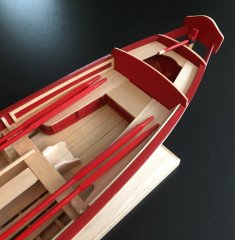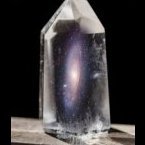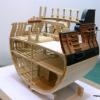
JerseyCity Frankie
-
Posts
1,338 -
Joined
-
Last visited
Reputation Activity
-
 JerseyCity Frankie got a reaction from mtaylor in Optimal Bowsprit Angle
JerseyCity Frankie got a reaction from mtaylor in Optimal Bowsprit Angle
This is an excellent question! I will throw out also that the pitching motion of the ship must be taken into account. Maximum pitch needs to be known to avoid the jibboom plunging into the sea. Broadly, A sailmaker and rigger would be juggling a LOT of math calculations and these would be driven by the Center of Effort of the entire rig, since the headsails job is to effect this imaginary point in space above deck by countering it-or altering it- with the collective Center of Effort of the headsails. These same considerations would be in play in determining the size and shape of the Spanker, for the exact same reasons. So the factors effecting the Steev of the Bowsprit are also effecting the angle of the Spanker Gaff. The higher off the water the tip of the Bowsprit, the higher the center of effort for the headsails will be.
-
 JerseyCity Frankie reacted to CRI-CRI in USS Confederacy 1778 by CRI-CRI - FINISHED - Model Shipways - scale 1/64
JerseyCity Frankie reacted to CRI-CRI in USS Confederacy 1778 by CRI-CRI - FINISHED - Model Shipways - scale 1/64
Some pics actual state of my Confederacy (January 2018 beginning) :
-
 JerseyCity Frankie got a reaction from mtaylor in Orient Express Sleeping Car 1929 by James H - Amati - 1/32
JerseyCity Frankie got a reaction from mtaylor in Orient Express Sleeping Car 1929 by James H - Amati - 1/32
I’m a huge fan of the 1974 Albert Finney film. Will you be using that remarkable film as a reference material? The interior scenes were shot on a soundstage but I wonder how closely the art department followed the actual trains appearance? Sad to hear of the passing of Mr Finney. I regard his performance in that film as being one of the most remarkable portrayals of a character in the history of cinema.
-
 JerseyCity Frankie got a reaction from popeye the sailor in Orient Express Sleeping Car 1929 by James H - Amati - 1/32
JerseyCity Frankie got a reaction from popeye the sailor in Orient Express Sleeping Car 1929 by James H - Amati - 1/32
I’m a huge fan of the 1974 Albert Finney film. Will you be using that remarkable film as a reference material? The interior scenes were shot on a soundstage but I wonder how closely the art department followed the actual trains appearance? Sad to hear of the passing of Mr Finney. I regard his performance in that film as being one of the most remarkable portrayals of a character in the history of cinema.
-
 JerseyCity Frankie got a reaction from Tigersteve in Model shipways flying fish
JerseyCity Frankie got a reaction from Tigersteve in Model shipways flying fish
No need to bend anything. Flip the model upside down on a big sheet of paper or card and trace carefully the outermost extent of all the frames/bulkheads. This line represents the outboard edge of the waterway. On your paper copy you then draw the inner edge of the waterway parallel and inside of the first line, as wide as your waterway is going to be. Note that you really need just one side of the ship as the symmetry should assure that one line works for both sides. Now cut out your paper waterway- it will be a long curved ribbon. Lay it onto the model to see if it fits and if it doesn’t fit perfectly cut it with scissors and patch it with tape until it’s perfect. Lay this pattern piece onto sheet stock (available wherever fine basswood is sold at craft stores) and cut with x-acto knife. Flip the pattern piece upside down and cut the other waterway. Glue.
-
 JerseyCity Frankie got a reaction from pontiachedmark in Model shipways flying fish
JerseyCity Frankie got a reaction from pontiachedmark in Model shipways flying fish
No need to bend anything. Flip the model upside down on a big sheet of paper or card and trace carefully the outermost extent of all the frames/bulkheads. This line represents the outboard edge of the waterway. On your paper copy you then draw the inner edge of the waterway parallel and inside of the first line, as wide as your waterway is going to be. Note that you really need just one side of the ship as the symmetry should assure that one line works for both sides. Now cut out your paper waterway- it will be a long curved ribbon. Lay it onto the model to see if it fits and if it doesn’t fit perfectly cut it with scissors and patch it with tape until it’s perfect. Lay this pattern piece onto sheet stock (available wherever fine basswood is sold at craft stores) and cut with x-acto knife. Flip the pattern piece upside down and cut the other waterway. Glue.
-
 JerseyCity Frankie got a reaction from mtaylor in Model shipways flying fish
JerseyCity Frankie got a reaction from mtaylor in Model shipways flying fish
No need to bend anything. Flip the model upside down on a big sheet of paper or card and trace carefully the outermost extent of all the frames/bulkheads. This line represents the outboard edge of the waterway. On your paper copy you then draw the inner edge of the waterway parallel and inside of the first line, as wide as your waterway is going to be. Note that you really need just one side of the ship as the symmetry should assure that one line works for both sides. Now cut out your paper waterway- it will be a long curved ribbon. Lay it onto the model to see if it fits and if it doesn’t fit perfectly cut it with scissors and patch it with tape until it’s perfect. Lay this pattern piece onto sheet stock (available wherever fine basswood is sold at craft stores) and cut with x-acto knife. Flip the pattern piece upside down and cut the other waterway. Glue.
-

-
 JerseyCity Frankie got a reaction from archnav in "How important is knowing the ropes? Thoughts on the ethics and practice of conserving ship model rigging." By Davina Kuh Jakobi, Chicago, IL May 31 2017
JerseyCity Frankie got a reaction from archnav in "How important is knowing the ropes? Thoughts on the ethics and practice of conserving ship model rigging." By Davina Kuh Jakobi, Chicago, IL May 31 2017
I'm picturing an imaginary medium sized museum with ten deteriorating models in storage. The board votes to address the fact that the models are rapidly deteriorating. Their duty to the museum is to take steps to assure the future of the collection so they hire you, as a professional, to stabilize the models so that they may be exhibited in the future. You, using your philosophy, only repair rigging that is actually parted or is cut at one end. Inside some of the cartons, no longer attached to the ship, are seven or eight long lengths of rotted rigging that came off the model. You can't tell where they originally were attached. Regardless of how you address the repairs, using your guiding principle of not replacing original rigging if it's still attached to the model, you deliver your restored models to the museum, your job is done. But within a month more rigging is coming loose on the models as the rigging continues to deteriorate. The models are NOT going to survive intact into the next decade, maybe not even into the next year. Your principle of not removing original material from the model only made sense for the brief amount of time between your deliver of the model until the next bit breaks off. You have NOT prepared the model for any sort of future at all. What exactly DID you do for that museum?
-
 JerseyCity Frankie reacted to Peter Bloemendaal in US Brig Syren by Peter Bloemendaal - FINISHED - Model Shipways - 1:64
JerseyCity Frankie reacted to Peter Bloemendaal in US Brig Syren by Peter Bloemendaal - FINISHED - Model Shipways - 1:64
Thanks Sven & Dutchman and thanks for all the likes.
I have been a bit quiet for a little while. I noticed I dropped a bit in motivation so took a few weeks break from modelling. Luckily it didn't last long...
I think I'm about halfway through the standing rigging so I thought it be a good time for a small update.
I also would like to wish everyone a Happy and prosperous New Year
(I got the happy bit sorted already because my first grandson was born yesterday 👍.)
Cheers, Peter
-
 JerseyCity Frankie got a reaction from J11 in Rigging Tightness
JerseyCity Frankie got a reaction from J11 in Rigging Tightness
By the way, I mentioned knots above. In my opinion the best knot for a temporary and adjustable knot to tie on say, a backstays, is the Rolling Hitch. Take the backstays down to the lower deadeye or whatever then around and up and tie a Rolling Hitch back on itself. It's a knot that will hold where you put it but one which you can easily adjust by sliding back and forth on whatever you hitched it to, without having to losen or untie or make any adjustments to the knot itself. You need to leave the backstays and all other standing rigging you want to be adjustable longer than necessary in order to have enough extra line to tie an adjustable knot in the end. The Rolling Hitch is ludicrously easy to learn and tie.
-
 JerseyCity Frankie reacted to SJSoane in Syren Rope Rocket
JerseyCity Frankie reacted to SJSoane in Syren Rope Rocket
I tried turning ropes with three strands, then mounting these again in the ropewalk and turning them together with the drill running in the opposite direction. This makes a a Z, or right turned rope, which I believe would be a hawser?
I did not get the tensions quite right, so there are some blips in it. It sets up powerful forces; trying to keep the headstock from unwinding was quite an experience! I had to unwind and then wind again, which probably did not help this rope much.
As I measure things, Chuck's supplied thread is .017 in diameter. Three of these turn up to .032, or a factor of 1.9 times the original thread diameter. And three of those three, or 9 threads altogether, turn up to about .059", again a factor of 1.9 times the diameters of the ropes in the second stage.
I have yet to try 3 threads in each eye, or 9 threads in one turning session. Will it be the same as turning the 9 threads in two sessions? It obviously changes the lay of S or Z.
Mark
-
 JerseyCity Frankie got a reaction from mtaylor in Rigging Tightness
JerseyCity Frankie got a reaction from mtaylor in Rigging Tightness
Ive restored a lot of old broken models and they usually come to me with a broken Bowsprit and broken tgallants or topmast. Always the broken Bowsprit, ALWAYS. I used to assume this was from the model falling off a shelf but now I’m not so sure. The first thing I try to do is to simply glue the broken piece back using the existing rigging. Again and again when I try to dry fit the busted spars back into their proper place the rigging is too tight to allow the jointing together of the pieces at the point where they broke. This leads me to believe it’s the RIGGING SHRINKING -over time- that breaks these spars, not the cat knocking the model off the shelf.
-
 JerseyCity Frankie got a reaction from Roger Pellett in Rigging Tightness
JerseyCity Frankie got a reaction from Roger Pellett in Rigging Tightness
Ive restored a lot of old broken models and they usually come to me with a broken Bowsprit and broken tgallants or topmast. Always the broken Bowsprit, ALWAYS. I used to assume this was from the model falling off a shelf but now I’m not so sure. The first thing I try to do is to simply glue the broken piece back using the existing rigging. Again and again when I try to dry fit the busted spars back into their proper place the rigging is too tight to allow the jointing together of the pieces at the point where they broke. This leads me to believe it’s the RIGGING SHRINKING -over time- that breaks these spars, not the cat knocking the model off the shelf.
-
 JerseyCity Frankie got a reaction from J11 in Rigging Tightness
JerseyCity Frankie got a reaction from J11 in Rigging Tightness
Things go badly when model rigging line is too tight. Certainly standing rigging shouldn't droop MUCH, But it should not be made as tight as it's possible to tighten it. Also, what you will discover as you rig is that tension set into one part of the rig at the beginning of the work is going to trouble you later over on another part of the rig.It's best to get ALL the stays and backstays on the completed masts BEFORE you set up all the tension. You are going to have to tune the rig at the end to get all the masts in line and not leaning one way and another, and you won't be able to make any adjustments if you cement every rope end in place as you work your way up. Tie the stays and backstays with knots you can untie and adjust at the final stage of rigging. THEN make them permanent only after you have sighted down the centerline of the model AND gauged the rake of all the masts. This advice will seam overblown as you are working on the lower rigging. But as you go higher the thinner spars are very flexible and they WILL bend in ways you do not want them to so keep all your tensioning options open until the last minute.
-
 JerseyCity Frankie got a reaction from peveka in Rigging Tightness
JerseyCity Frankie got a reaction from peveka in Rigging Tightness
By the way, I mentioned knots above. In my opinion the best knot for a temporary and adjustable knot to tie on say, a backstays, is the Rolling Hitch. Take the backstays down to the lower deadeye or whatever then around and up and tie a Rolling Hitch back on itself. It's a knot that will hold where you put it but one which you can easily adjust by sliding back and forth on whatever you hitched it to, without having to losen or untie or make any adjustments to the knot itself. You need to leave the backstays and all other standing rigging you want to be adjustable longer than necessary in order to have enough extra line to tie an adjustable knot in the end. The Rolling Hitch is ludicrously easy to learn and tie.
-
 JerseyCity Frankie got a reaction from thibaultron in Rigging Tightness
JerseyCity Frankie got a reaction from thibaultron in Rigging Tightness
Ive restored a lot of old broken models and they usually come to me with a broken Bowsprit and broken tgallants or topmast. Always the broken Bowsprit, ALWAYS. I used to assume this was from the model falling off a shelf but now I’m not so sure. The first thing I try to do is to simply glue the broken piece back using the existing rigging. Again and again when I try to dry fit the busted spars back into their proper place the rigging is too tight to allow the jointing together of the pieces at the point where they broke. This leads me to believe it’s the RIGGING SHRINKING -over time- that breaks these spars, not the cat knocking the model off the shelf.
-
 JerseyCity Frankie got a reaction from thibaultron in Rigging Tightness
JerseyCity Frankie got a reaction from thibaultron in Rigging Tightness
Things go badly when model rigging line is too tight. Certainly standing rigging shouldn't droop MUCH, But it should not be made as tight as it's possible to tighten it. Also, what you will discover as you rig is that tension set into one part of the rig at the beginning of the work is going to trouble you later over on another part of the rig.It's best to get ALL the stays and backstays on the completed masts BEFORE you set up all the tension. You are going to have to tune the rig at the end to get all the masts in line and not leaning one way and another, and you won't be able to make any adjustments if you cement every rope end in place as you work your way up. Tie the stays and backstays with knots you can untie and adjust at the final stage of rigging. THEN make them permanent only after you have sighted down the centerline of the model AND gauged the rake of all the masts. This advice will seam overblown as you are working on the lower rigging. But as you go higher the thinner spars are very flexible and they WILL bend in ways you do not want them to so keep all your tensioning options open until the last minute.
-
 JerseyCity Frankie got a reaction from Richard Griffith in Brass railing. Black or brass?
JerseyCity Frankie got a reaction from Richard Griffith in Brass railing. Black or brass?
It’s true all the brass on a ship is going to be regularly polished. But in my opinion there’s WAY too much bright shiny brass on miniature ship models. Particularly what I’m thinking of is the two-tone ship model that has two colors: the dark brown of the varnished wood and the outrageously shiny brass flecked all over the hull and deck. On these models everything made of metal (and many things that are not!) are bright shiny brass. In my view the only things that should be shinny brass are the bell and the actual handrails -not the railing supports not the hinges on the doors, not the pintels and gudgeons, not the block strops or hooks, or the sheaves, not the anchor and certainly not any chain anywhere.....you get the picture.
-
 JerseyCity Frankie got a reaction from davyboy in Brass railing. Black or brass?
JerseyCity Frankie got a reaction from davyboy in Brass railing. Black or brass?
It’s true all the brass on a ship is going to be regularly polished. But in my opinion there’s WAY too much bright shiny brass on miniature ship models. Particularly what I’m thinking of is the two-tone ship model that has two colors: the dark brown of the varnished wood and the outrageously shiny brass flecked all over the hull and deck. On these models everything made of metal (and many things that are not!) are bright shiny brass. In my view the only things that should be shinny brass are the bell and the actual handrails -not the railing supports not the hinges on the doors, not the pintels and gudgeons, not the block strops or hooks, or the sheaves, not the anchor and certainly not any chain anywhere.....you get the picture.
-
 JerseyCity Frankie got a reaction from Maury S in Brass railing. Black or brass?
JerseyCity Frankie got a reaction from Maury S in Brass railing. Black or brass?
It’s true all the brass on a ship is going to be regularly polished. But in my opinion there’s WAY too much bright shiny brass on miniature ship models. Particularly what I’m thinking of is the two-tone ship model that has two colors: the dark brown of the varnished wood and the outrageously shiny brass flecked all over the hull and deck. On these models everything made of metal (and many things that are not!) are bright shiny brass. In my view the only things that should be shinny brass are the bell and the actual handrails -not the railing supports not the hinges on the doors, not the pintels and gudgeons, not the block strops or hooks, or the sheaves, not the anchor and certainly not any chain anywhere.....you get the picture.
-
 JerseyCity Frankie got a reaction from peveka in Brass railing. Black or brass?
JerseyCity Frankie got a reaction from peveka in Brass railing. Black or brass?
It’s true all the brass on a ship is going to be regularly polished. But in my opinion there’s WAY too much bright shiny brass on miniature ship models. Particularly what I’m thinking of is the two-tone ship model that has two colors: the dark brown of the varnished wood and the outrageously shiny brass flecked all over the hull and deck. On these models everything made of metal (and many things that are not!) are bright shiny brass. In my view the only things that should be shinny brass are the bell and the actual handrails -not the railing supports not the hinges on the doors, not the pintels and gudgeons, not the block strops or hooks, or the sheaves, not the anchor and certainly not any chain anywhere.....you get the picture.
-
 JerseyCity Frankie got a reaction from Roger Pellett in Brass railing. Black or brass?
JerseyCity Frankie got a reaction from Roger Pellett in Brass railing. Black or brass?
It’s true all the brass on a ship is going to be regularly polished. But in my opinion there’s WAY too much bright shiny brass on miniature ship models. Particularly what I’m thinking of is the two-tone ship model that has two colors: the dark brown of the varnished wood and the outrageously shiny brass flecked all over the hull and deck. On these models everything made of metal (and many things that are not!) are bright shiny brass. In my view the only things that should be shinny brass are the bell and the actual handrails -not the railing supports not the hinges on the doors, not the pintels and gudgeons, not the block strops or hooks, or the sheaves, not the anchor and certainly not any chain anywhere.....you get the picture.
-
 JerseyCity Frankie got a reaction from mtaylor in Brass railing. Black or brass?
JerseyCity Frankie got a reaction from mtaylor in Brass railing. Black or brass?
It’s true all the brass on a ship is going to be regularly polished. But in my opinion there’s WAY too much bright shiny brass on miniature ship models. Particularly what I’m thinking of is the two-tone ship model that has two colors: the dark brown of the varnished wood and the outrageously shiny brass flecked all over the hull and deck. On these models everything made of metal (and many things that are not!) are bright shiny brass. In my view the only things that should be shinny brass are the bell and the actual handrails -not the railing supports not the hinges on the doors, not the pintels and gudgeons, not the block strops or hooks, or the sheaves, not the anchor and certainly not any chain anywhere.....you get the picture.
-
 JerseyCity Frankie got a reaction from thibaultron in Making block
JerseyCity Frankie got a reaction from thibaultron in Making block
I wasn’t happy with the kit-supplied double blocks for my Model Shipways Niagara model. The kit supplies only two sizes of double blocks and apparently this is ok for most of the rig but the big sheet blocks on the main required bigger than the kit allowed for. There would be only two needed so I made them by laminating stripwood.










